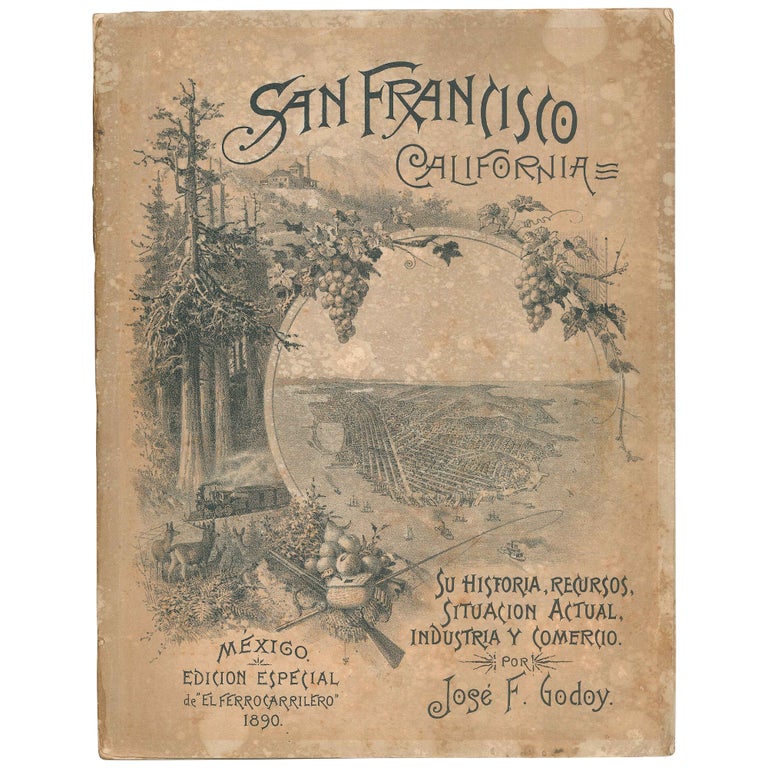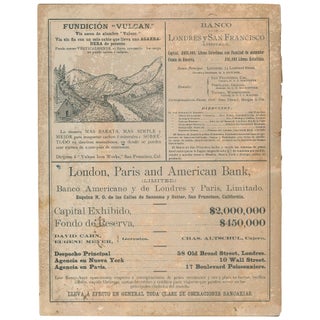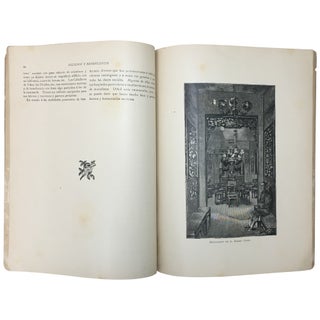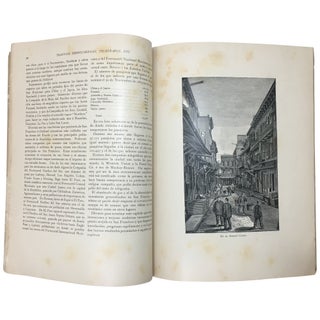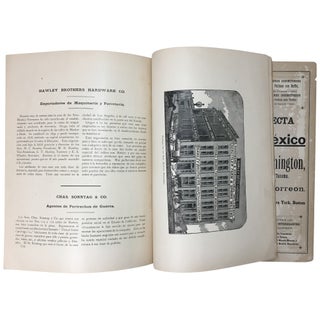Scarce Spanish-Language Guide to San Francisco by a Mexican-American Writer
San Francisco, California: Su historia, recursos, situación actual, industria, y comercio
Notes: A scarce 19th-century Spanish-language guide to San Francisco by a Mexican American author, printed in San Francisco by the Pacific Press. The book is illustrated with twenty-five full-page steel engravings and many in-text illustrations, plus a bird's-eye view of the city and a map of central California, from San Luis Obispo to San Francisco.
According to Godoy, in his introduction, "Few cities in the United States are as agreeable and interesting for Mexicans as San Francisco" (translation by your cataloguer). He offers the typical information found in booster publications, extolling the city's population growth, notable buildings, manufacturing, and export figures. He has chapters on public education, transportation, and climate.
As a Mexican immigrant (with an American mother), Godoy seems sensitive to other immigrant groups. He also devotes one chapter to "Las colonias extrangeras" (roughly, immigrant communities), with specific attention given to the Irish, German, Mexican, French, and Chinese communities. Three of the full-page illustrations are of Chinatown. At the time of the publication of this guide, the US had passed the Chinese exclusion act and San Francisco had enacted ordinances to restrict the Chinese in the city (following a virulently racist 1885 municipal report on Chinatown). Yet Godoy's view is one of acceptance and even admiration. He notes that the Chinese give white people ("la raza blanca") a run for their money in the manufacture of shoes and cigars (p. 12). He points out that while in 1888 the health department had issued 530 citations to Chinese residents, ten times as many were issued to other nationalities (p. 30).
About the Mexican community in San Francisco, Godoy writes, "The population of our countrymen is rather numerous, although unfortunately the financial circumstances of many of them is not good." He notes that most Mexican immigrants are from the states of Sonora and Sinaloa. He writes that there was a Mexican mutual benefit society in the city (though he does not mention he was one of the founders of the group in 1877), a Mexican Catholic church, and two Mexican weekly newspapers.
The back of the book offers descriptions of thirty-three businesses, some illustrated with engravings. The inside and back covers of the book have ads and there is a full-page ad near the end of the book for Tauzy, Carvajal y Cia., a Spanish-French bookstore in San Francisco. There are also several pages of ads for Godoy's previous books and the newspaper El Ferrocarrilero.
93, [7] pages. 9 by 11-3/4 inches.
** ABOUT THE AUTHOR **
José F. Godoy (1851–1930) was born in Mexico to an American mother from Louisiana and a Mexican father. His parents likely met in New Orleans when Godoy's father was editing a Spanish-language newspaper in that city. The family moved to San Francisco in 1865 and Godoy lived there for most of the next 20 years. He left school when his father died in 1869, won the contract to be the official California state translator for two legislative terms, published a couple of novels and a few plays, and passed the bar without attending law school. He became a naturalized US citizen in 1873.
In the late 1880s, Godoy started a daliy Spanish-English newspaper in Mexico City, El Ferrocarrilero. The only surviving issues I could locate were from its third year, in 1890. By 1891 or 1892 (sources differ), Godoy was back in San Francisco, where one of his sons was born. He followed his father in the Mexican diplomatic service, assuming the post of Consul in San Francisco, a position his father held from 1865 to 1869. Godoy later spent many years in Washington, DC and New York, with other postings in Havana and Guatemala. He left the US sometime after 1920 and died in Mexico in 1930.
Godoy was the second of at least three generations of writers and diplomats who passed seamlessly between the US and Mexico, speaking both English and Spanish fluently, and with parents and children born on both sides of the border.
Edition + Condition: First edition (first printing). Some spotting to covers, portions of the unprinted spine perished, but intact.
Publication: México: Edicion especial de "El Ferrocarrilero" 1890.
Item No: #307247
Sold

